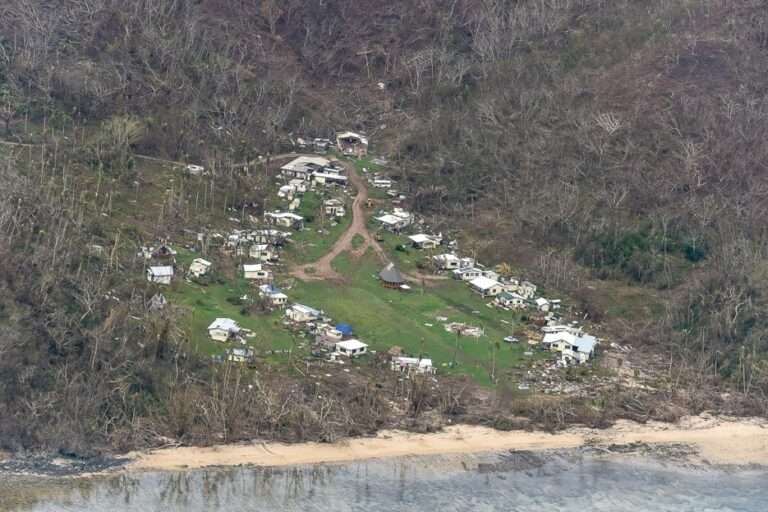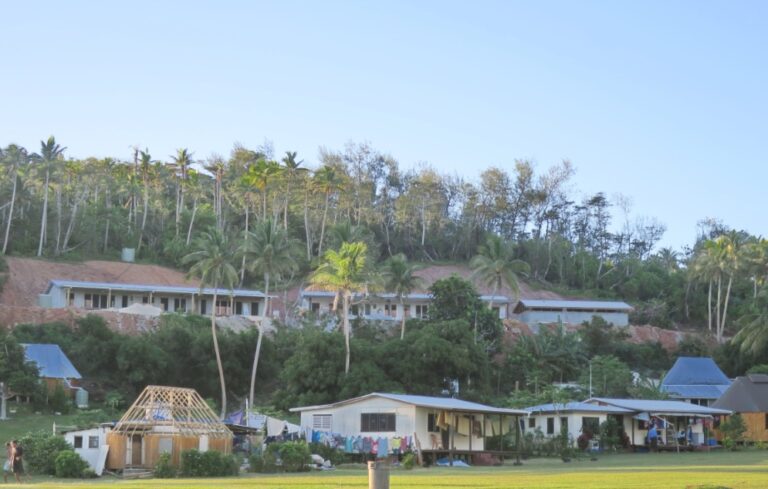© 2011-2024 The Avataric Samrajya of Adidam Pty Ltd, as trustee for the Avataric Samrajya of Adidam. All rights reserved.
Posted July 2020

Since Avatar Adi Da Samraj took up residence at Naitauba in 1983, many of the existing buildings were remodeled or repurposed to sacred and practical uses as required by the ashram. The majority of these existing structures were situated at sea level or just above (as is the case throughout Fiji). In the early 2000’s, the risk of significant sea level rise due to climate change became clear, and a comprehensive plan began to be developed that lays out a long-term vision for all sacred and practical development on the island, including self-sufficiency, economy, ecology, and potential impacts of climate change.
Since reconstructing all sea-level structures on higher ground is such an immense and expensive undertaking, island management wanted to examine options to protect existing buildings at sea level. Therefore, coastal engineers from New Zealand were invited to Naitauba to provide advice on how to protect the most vulnerable facilities at sea level. Their fundamental advice corroborated Avatar Adi Da’s instructions—by far the best thing to do was to move to higher ground.
At the request of Naitauba’s island management, the coastal engineers also outlined a plan for constructing seawalls around the most important structures, for example the Matrix temple complex on the east side of the island. That plan was about to be initiated when Cyclone Winston struck in February 2016. Even had it been constructed, a seawall would have hardly protected the Matrix structures from the extreme storm surge that accompanied Cyclone Winston. It was now clear that all significant structures on Naitauba must be rebuilt on higher ground. Seawalls and strengthened buildings near sea level are a temporary and tenuous form of protection at best.
The first question regarding the move to higher ground was: What elevation above current sea level is adequate to protect against future sea-level rise and storm surges? Scientific studies forecast a sea-level rise of up to 6 feet by the end of this century. Storm-surge heights are measured from mean sea level, which is about 3 feet below high tide. Thus, if a storm surge occurs at high tide (+3 feet) and the sea level increases by 6 feet, that sets a future baseline of 9 feet above current sea level. The storm surge at Naitauba during Cyclone Winston was about 7 feet based on water damage visible after the storm (although exact measurements were not made). For planning purposes, a storm surge of 10 feet (3 feet higher than during Cyclone Winston) appears adequate. Adding a 10-foot surge to the future baseline of 9 feet, the minimum safe elevation above current sea level for new construction is 19 feet. We settled on 20 feet for practical structures. Any practical structures are expected to last 50 to 70 years, so they can be rebuilt higher than 20 feet when they require rebuilding.
However, sacred facilities must be even higher because we never want to move or rebuild them. Worst-case climate scenarios predict a sea-level increase of 50 feet or more in the next few centuries. Such a rise would alter the shoreline geography of the entire planet and many cities and some countries, especially island nations, would be lost. The hope is that humanity will take radical measures to mitigate climate change before such an outcome. Our working principle, therefore, is that sacred facilities should be located at least 50 feet above current sea level.
Immediately after Cyclone Winston, while the island’s foliage was greatly reduced, a cartography team from Canada graciously visited Naitauba. Using two drones, they mapped the elevation of the entire island. Then, a team of architects, engineers, and builders surveyed the areas where the topography appeared adequate. They discovered several suitable locations of stillness and beauty that had not been previously accessed due to the dense vegetation and steep terrain.
It is of great importance to the sacred integrity of Adi Da Samrajashram that the process of migrating all sacred facilities to higher ground is completed before they are further endangered by the effects of climate change. Avatar Adi Da Samraj provided principles for selecting sacred sites. One of these principles involves proximity to or unobstructed views of water. The planning team had identified several sites at higher elevations with clear and sweeping views of the surrounding ocean.

The safety of the island’s residents is also of great importance. Fortunately, no residents were injured during Cyclone Winston. This includes the residents of Ciqomi, which was hit by a storm surge as well as extreme winds. Most Ciqomi residents sheltered in the community bure during the storm, which was not designed to withstand Cyclone Winston or the extreme storms that can be expected in the future. A new school was needed for the same reason. Therefore, a dual-purpose school and cyclone refuge has been constructed, large enough to accommodate all the residents of Ciqomi. These buildings, located 70 feet above sea level, are extremely strong with steel beams, a steel roof, and reinforced-concrete walls.
Although it has been clear for some time that Naitauba would need to be prepared for the impacts of climate change, there was some question about the urgency and timing. Cyclone Winston was a loud wake-up call. The time is now. The engineering studies after the cyclone revealed how a gradual move to higher ground was practically possible. The move to higher ground has already begun. This would not be possible without the generous support from the community of Adidam devotees and friends.
© 2011-2024 The Avataric Samrajya of Adidam Pty Ltd, as trustee for the Avataric Samrajya of Adidam. All rights reserved.